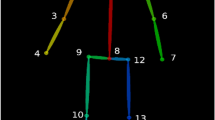Abstract
In this work, we revisit multi-resolution analysis (MRA) methods for object recognition. We find an optimal sparse representation of an image using a second-generation Fast Discrete Curvelet Transform (FDCT) and present a novel curvelet approach based on thin plate splines (TPS). Measurement of local deformation at each FDCT coefficient is detailed. Specific deformations in the TPS-based curve-let transformation are identified by minimization (Curvature) of total bending energy. Shape toning is processed through the Euclidean distance. Results of implementation of proposed descriptor for five standard databases are analyzed, while their comparison with other revealed relative efficiency.










Similar content being viewed by others
References
Zhang D, Lu G (2004) Review of shape representation and description techniques. Pattern Recogn 37(1):1–19
Pitas I (2000) Digital image processing, algorithms and application. Wiley, New York
Nixon MS, Aguado AS (2002) Feature extraction and image processing, 1st edn. Newnes Publishers, Oxford, pp 247–287
Starck JL, Elad M, Donoho D (2004) Redundant multiscale transforms and their application for morphological component separation. Adv Imaging Electron Phys 132:287–348
Mojsilovic A, Popovic M, Markovic S, Krstic M (1998) Characterization of visually similar diffuse diseases from Bscan liver images using nonseparable wavelet transform. IEEE Trans Med Imaging 17(4):541–549
Alzu’bi S, Amira A (2010) 3D medical volume segmentation using hybrid multiresolution statistical approaches. Adv Artif Intell 2010:1–15
Mulcahy C (1997) Image compression using the Haar wavelet transform. Spelman Sci Math J 1:22–31
Fourati W, Kammoun F, Bouhlel MS (2005) Medical image denoising using wavelet thresholding. J Test Eval 33(5):364–369
Kara B, Watsuji N (2003) Using wavelets for texture classification. J WSEAS Trans Comput 2(4):920–924
Chen GY, Bui TD, Krzyżak A (2009) Invariant pattern recognition using radon, dual-tree complex wavelet and Fourier transforms. Pattern Recogn 42(9):2013–2019
Alina B, Ambar D (2013) Performance comparison of cosine, haar, walsh-hadamard, fourier and wavelet transform for shape based image retrieval using fuzzy similarity measure. Proc Technol 10:623–627
Candès E, Demanet L (2005) The curvelet representation of wave propagators is optimally sparse. Commun Pure Appl Math 58(11):1472–1528
Candès E, Demanet L, Donoho D, Ying L (2006) Fast discrete curvelet transforms. Multiscale Model Simul 5(3):861–899
Jianwei M, Plonka G (2010) The curvelet transform. IEEE Signal Process Mag 27(2):118–133
Arivazhagan S, Ganesan L, Kumar TGS (2006) Texture classification using curvelet statistical and co-occurrence features, pattern recognition. In: 18th international conference on ICPR 2006, vol 2, pp 938–941
Qing-Wu L, Guo-Gao L (2007) eramic microscopic image processing based on fast discrete curvelet transform, Wavelet Analysis and Pattern Recognition. In: ICWAPR ’07. International Conference vol 1, pp 344–349
Yungang Z, Lijin G, Wei G, Jun L (2010) ombining color quantization with curvelet transform for image retrieval, Artificial Intelligence and Computational Intelligence (AICI). In: International Conference on vol 1, pp 474–479
Chi Z, Hongbin Z (2010) Identifying color image origin using curvelet transform, Image Processing (ICIP). In: 17th IEEE International Conference on, pp 2125–2128
Prasad S, Kumar P, Tripathi RC (2011) Plant leaf species identification using Curvelet transform, Computer and Communication Technology (ICCCT). In: 2nd International Conference on, pp 646–652
Minhas R, Mohammed AA, Wu QMJ, Sid-Ahmed MA (2011) A robust object detection approach using boosted anisotropic multiresolution analysis, Circuits and Systems (MWSCAS). In: 54th international midwest symposium on IEEE 2011, pp 1–4
Esmaeili M, Rabbani H, Dehnavi AM, Dehghani A (2012) Automatic detection of exudates and optic disk in retinal images using curvelet transform. IET Image Proc 6(7):1005–1013
Ezekiel S, Alford MG, Ferris D, Jones E, Bubalo A, Gorniak M, Blasch E (2013) Multi-scale decomposition tool for content based image retrieval, applied imagery pattern recognition workshop: sensing for control and augmentation. In: 2013 IEEE (AIPR), pp 1–5
Bin H, Islam KK (2013) A comparative analysis of processing periods for strain images generated using 1D spline based approach and 2D thin plate smoothing spline method. In: International conference on informatics, electronics & vision (ICIEV), pp 1–6
Candes EJ, Donoho DL (2000) Curvelets—A surprisingly effective non- adaptive representation for objects with edges. Vanderbilt University Press, Nashville
Bookstein FL (1991) Morphometric tools for landmark data: geomtery and biology. Cambridge University Press, Cambridge
Zhang G, Ma ZM, Tong Q, He Y, Zhao T (2008) Shape feature extraction using fourier descriptors with brightness in content based medical image retrieval. In: International conference on intelligent information hiding and multimedia signal processing, pp 71–74
Tiagrajah VJ, Razeen AASM (2011) An enhanced shape descriptor based on radial distances. In: IEEE international conference on signal and image processing applications, pp 472–477
Sebastian P, Klein T, Kimia B (2004) Computationally efficient wavelet affine invariant functions for shape recognition. IEEE Trans Pattern Anal Mach Intell 26:550–571
Whoi YSK (2000) A region-based shape descriptor using Zernike moments. Signal Process 16:95–102
Mokhtarian F, Abbasi F, Kittler J, Smeulders AWM, Jain R (1997) Efficient and robust retrieval by shape content through curvature scale space. Image Databases Multi Media Search 8:51–58
Ghazal AE, Basir O, Belkasim S (2009) Farthest point distance: a new shape signature for Fourier descriptors. Sig Process Image Commun 24:572–586
Ghazal AE, Basir O, Belkasim S (2012) Invariant curvature-based Fourier shape descriptors. J Visual Commun Image Represent 23:622–633
Pedrosa Glauco V, Batista Marcos A, Barcelos Celia AZ (2013) Image feature descriptor based on shape salience points. Neuro Comput 23:156–163
Mani MR, Varma GPS, Potukuchi DM, Satyanarayana Ch (2015) A conformal mapping based shape signature for object recognition. In: Proceedings of the 15th international conference on applied computer science. Konya, pp 183–187
Author information
Authors and Affiliations
Corresponding author
Rights and permissions
About this article
Cite this article
Mani, M.R., Potukuchi, D.M. & Satyanarayana, C. A novel approach for shape-based object recognition with curvelet transform. Int J Multimed Info Retr 5, 219–228 (2016). https://doi.org/10.1007/s13735-016-0107-6
Received:
Revised:
Accepted:
Published:
Issue Date:
DOI: https://doi.org/10.1007/s13735-016-0107-6




